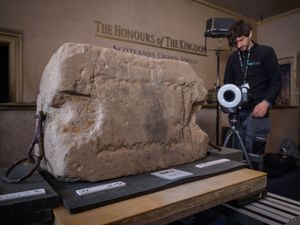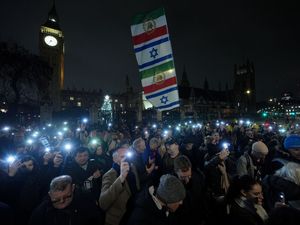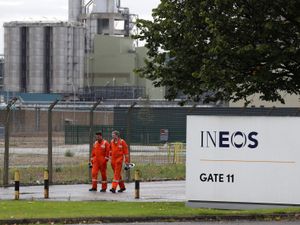Expert believes she has unravelled Stone of Destiny’s Roman numeral mystery
XXXV is inscribed on the historic stone, in a place which would have been difficult to access.

The researcher who is trying to trace the “hidden” fragments of the Stone of Destiny believes she has decoded another mystery of the ancient artefact – Roman numerals which were etched on to it.
A detailed 3D scan was made of the Stone of Scone ahead of the King’s coronation in 2023.
This revealed the Roman numerals XXXV were inscribed on a part of the 152kg sandstone block which would have been difficult to access.
Historic Environment Scotland, which carried out the scan and produced a virtual 3D model of the stone, said it had been unable to ascertain the purpose or meaning of the inscription.
However Prof Sally Foster of Stirling University believes they may be a relatively modern addition to the centuries-old object and linked to her other area of research.

Her theory points to the marking being made by Bertie Gray, the stonemason and nationalist politician who oversaw the secret repair of the stone in 1951.
During the famous raid on Westminster Abbey in 1950, when four students spirited the stone back to Scotland, it split in two and Mr Gray later oversaw the work to repair it
Last week, the PA news agency reported Prof Foster’s appeal to help trace the stories of more than 30 fragments of the original stone which were created during Mr Gray’s work.
Prof Foster has already received word of several fragments which remain in private ownership, including one which ended up in Orkney.
Her research has led her to believe Mr Gray’s work led to as many as 34 carefully numbered and recorded pieces.
While the theory may be impossible to prove, the Roman numeral of 35 could refer to Mr Gray seeing the Stone of Destiny itself as the 35th “fragment”.
Prof Foster told the PA news agency she had come to the realisation this week, saying: “The penny dropped: 34 fragments plus one stone equals 35.

“Of course I can’t prove this, but what else might it be?”
Mr Gray never publicly revealed exactly how many pieces he distributed and he died in 1975.
Prof Foster said: “He’s writing on it ‘this is the 35th’.
“It fits in with his sense of humour and with him putting his own mark on the stone.”
She argues there would have been few circumstances – other than the masonry work – in which anyone would have been able to access the lower part of the stone where the XXXV inscription can be seen.
An article in the Calgary Herald from April 1951 refers to Mr Gray himself putting the “finishing touches” on the repair to the stone and being proud of his work.

The article’s author Dick Sanburn is one of those who received a fragment from Mr Gray – he kept piece number 25 behind his desk in the Canadian newspaper’s office.
Other fragments were given to people in and around the nationalist movement.
The Commissioners for the Safeguarding of the Regalia – the body of senior officials charged with overseeing the Scottish crown jewels – are currently considering what should happen with a fragment gifted to Alex Salmond which was kept in the SNP’s headquarters.
Prof Foster is keen to hear from people who may own, or know of, one of the fragments of the Ssone which were distributed by Mr Gray.
She can be contacted on her project’s website, thestone.stir.ac.uk, or through Stirling University.
A spokeswoman for Historic Environment Scotland said: “We don’t know for certain when these markings were made on the stone, or what they signify. While they have the appearance of Roman numerals, this does not necessarily mean they date to Roman times.
“The appearance of the markings and the fact they have not been recorded previously suggest they may have been carved more recently. We hope this will be an area for further research.”





